MARIANI’SVirtual
Gourmet
September 22, 2013
NEWSLETTER
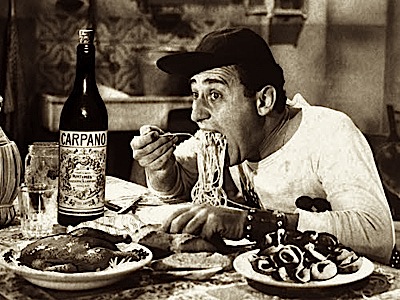
Alberto
Sordi in "Un Americano a Roma" (1954)
☛
In
This Issue
A ROMANTIC
ITALIAN JOURNEY, Part Two
by Misha Mariani
NEW YORK
CORNER
Andanada
by John Mariani
NOTES
FROM THE WINE CELLAR
OREGON RIESLINGS RIVAL
EUROPE'S BEST
by John Mariani
A ROMANTIC ITALIAN JOURNEY, Part Two
by Misha Mariani

Il Borgo, Castello Banfi, Montalcinoa
In
all the
years and trips past, I have visited Italy a handful
of times, scouring the
canals of Venice, the rolling hills of Tuscany, the
beaches and islands of
Amalfi, and the great cities of Rome and Naples but
the one region
that has evaded me until this summer that I’ve had the
burning desire to see is the
Island of Sicily. An Island referred to in Homer’s
"Odyssey"
and the subject of the iconic Lampedusa novel Il Gattopardo,
Sicily has a long history and overlapping cultures of
the many other civilizations that have conquered it,
from Greece to France. It has some of the most
beautiful beaches, expansive fields of gold
wheat and a still very active volcano making up some
of the most gorgeous
landscapes to be captured. This is a diverse and
glorious land!
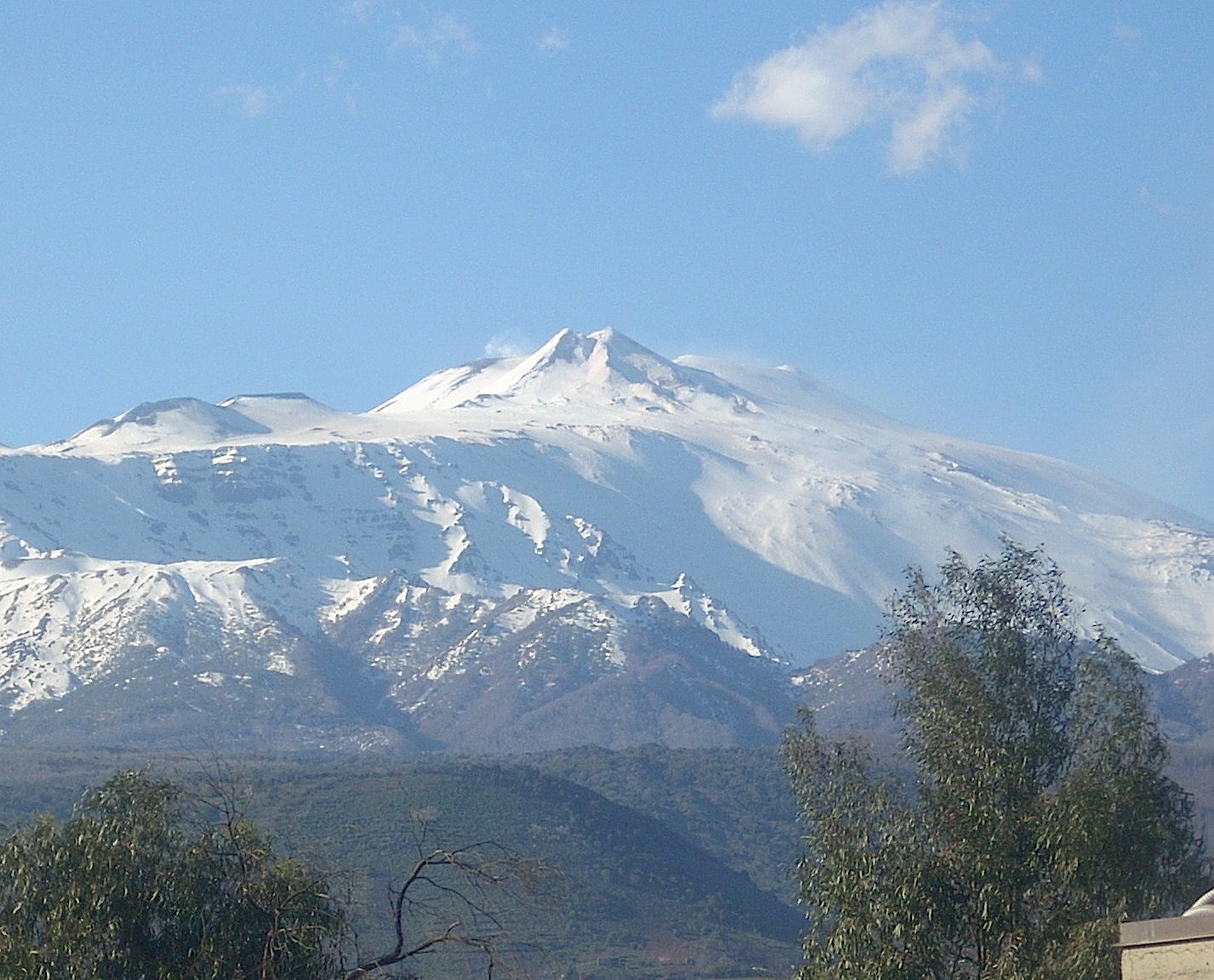 As our flight neared the coast of
Sicily, we looked out our window and saw the flat farm
land with the backdrop of a Mt. Etna (left), the
tallest active volcano in
Europe, towering over 3,300 meters--a truly
captivating sight. We
landed in the bustling city of Catania, where we had
no intention of staying,
but were off to Taormina, the small coastal city
perched 204 meters above
the sea on a hilltop supposedly inhabited by native
tribes over 2,600 years ago.
As our flight neared the coast of
Sicily, we looked out our window and saw the flat farm
land with the backdrop of a Mt. Etna (left), the
tallest active volcano in
Europe, towering over 3,300 meters--a truly
captivating sight. We
landed in the bustling city of Catania, where we had
no intention of staying,
but were off to Taormina, the small coastal city
perched 204 meters above
the sea on a hilltop supposedly inhabited by native
tribes over 2,600 years ago.
We rented a
Fiat Panda, packed our luggage into the backseat,
because it definitely would not all
fit in the boot, and sped off, windows down, wind in
our hair, and
the salty coastal air filling our lungs. After a quick
40-minute drive from
Catania, we hopped off the highway onto a winding road
hugging the coast and made
our way to the Grand
Hotel Atlantis Bay. The hotel isn’t located in
the perched town of Taormina (below), but actually down on
the
coast, nestled in a seaside cove of the Ionian Sea and
its crystal clear deep
blue waters. Just three-minute walk from a gondola
will bring you to the
town's epicenter.
Photo by
Jeanne Bolyn
When we arrived, we were greeted by a warm
staff and escorted through 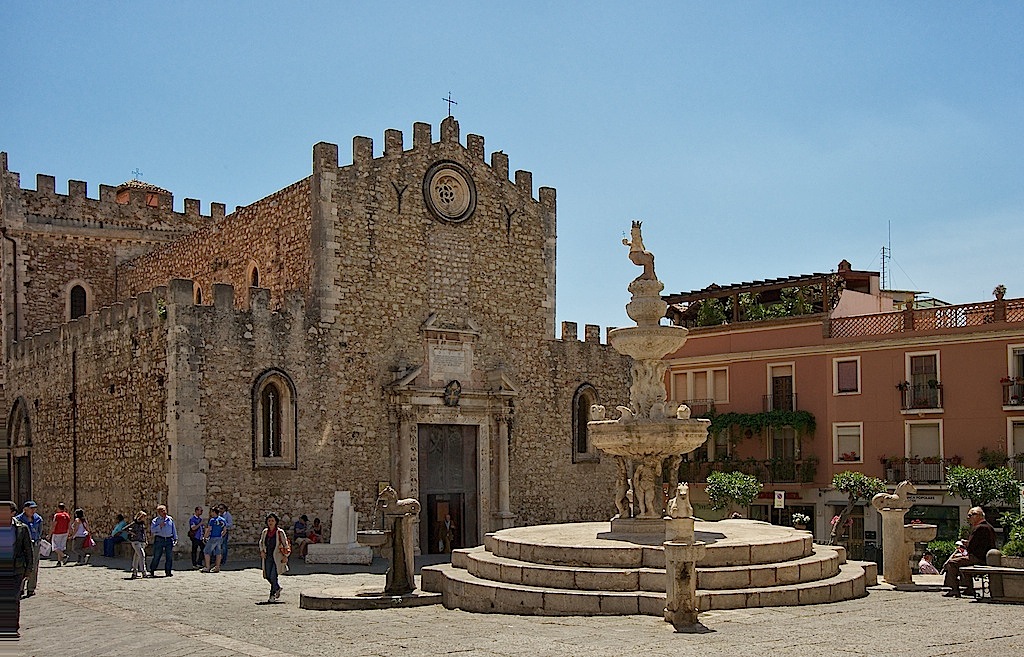 their cave-like hallways to
our room, with the décor of an
elevated beach home,
with wooden floors, glass tables, wooden armor, and
its very own terrace decked with with lounge
chairs, a breakfast table and dining chairs. Oh,
did I mention,
this terrace sat overlooking those same blue
waters? Hands
down, this is some of the most beautiful scenery
I have been ever exposed to you
in all the hotels and resorts I have stayed at. Our
room was a double, but the hotel also has
five more higher level suite options to spoil
you.
their cave-like hallways to
our room, with the décor of an
elevated beach home,
with wooden floors, glass tables, wooden armor, and
its very own terrace decked with with lounge
chairs, a breakfast table and dining chairs. Oh,
did I mention,
this terrace sat overlooking those same blue
waters? Hands
down, this is some of the most beautiful scenery
I have been ever exposed to you
in all the hotels and resorts I have stayed at. Our
room was a double, but the hotel also has
five more higher level suite options to spoil
you.
Atlantis Bay (below) is not
only a place to rest your head at night after a
long day of
sight seeing and strolling through town Taormina. It
offers some of the region's most sophisticated
cuisine. There is the Bar Dioniso where
you can sip a glass of sparkling rosato or an
Aperol Spritz and nibble on some
of the chefs attentively created stuzzichini or
sit down in the Ristorante Ippocampo
for a proper meal, looking out onto the lights
that sparkle along the coast of the island cove while
enjoying carefully
executed cuisine typical of the region and of the
freshest sea creatures
caught that day off the coast. Outdoor dining is also
available, a luxury I
would snatch up in a minute if the weather is
cooperating.
Grand Hotel Atlantis Bay also has a counterpart
a few doors down called Mazzaro
Sea Palace. If Atlantis Bay is your
quiet sea side beach house, then Mazzaro
Sea Palace is the more elaborate resort alternative.
I’ll take the beach
house.
 So, after four days in Sicily, it was back to
Tuscany again, landing in Florence. We rented
Fiat 500 this time,
punched in our coordinates to Google Maps--an absolute
and dependable necessity these days!--and sped off to
our final destination
for the day, the Four Seasons Hotel
Firenze. After what we thought
was the most
luxurious 4 days we could have possibly had, the Four
Seasons makes
everything else seem modest.
So, after four days in Sicily, it was back to
Tuscany again, landing in Florence. We rented
Fiat 500 this time,
punched in our coordinates to Google Maps--an absolute
and dependable necessity these days!--and sped off to
our final destination
for the day, the Four Seasons Hotel
Firenze. After what we thought
was the most
luxurious 4 days we could have possibly had, the Four
Seasons makes
everything else seem modest.
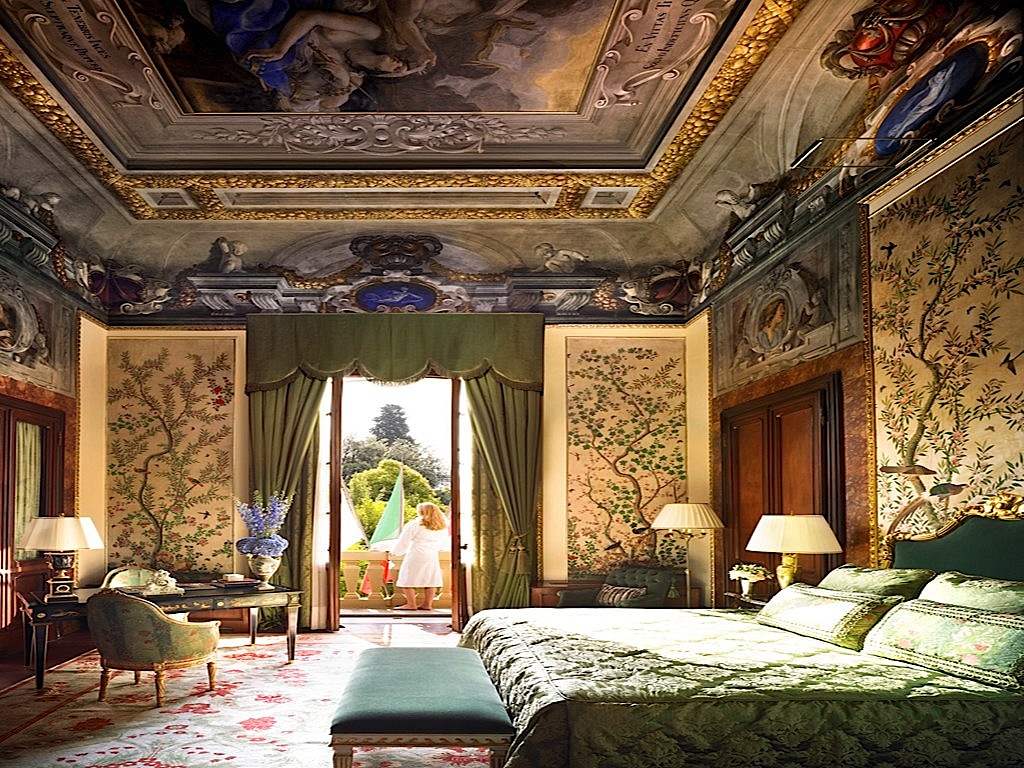 The Four
Seasons Hotel (left)
resides within in the Palazzo Della
Gherardesca, built
in the mid to late 15th century. At the time, Palazzo
Della Gherardesca
was one of a kind, the prototype of much copied
architectural designs that consisted of
numerous town houses surrounding a garden or park,
which found popularity in
the 18th century. The Four Seasons took over in 2008,
renovated the space
while adhering to the restrictions of the General
Directorate of Antiquities
and Fine Arts and has managed to effect perhaps one of
the most luxurious resorts in
Florence, let alone the world.
The Four
Seasons Hotel (left)
resides within in the Palazzo Della
Gherardesca, built
in the mid to late 15th century. At the time, Palazzo
Della Gherardesca
was one of a kind, the prototype of much copied
architectural designs that consisted of
numerous town houses surrounding a garden or park,
which found popularity in
the 18th century. The Four Seasons took over in 2008,
renovated the space
while adhering to the restrictions of the General
Directorate of Antiquities
and Fine Arts and has managed to effect perhaps one of
the most luxurious resorts in
Florence, let alone the world.
Simply put, this hotel is
heaven paired with culture. Decorations are
gorgeous throughout,
fitted with the grandest, most luxurious materials
available; and if not available, the hotel had them
made to their period specifications--the finest
marbles
and wood specimens, the highest thread count linens
you could imagine. To match, there is a
thoroughly and professionally trained staff, a superb
wine collection, Richard Ginori china, crystal
glassware, and so on to every detail. English is
spoken by nearly the entire staff.
Inside the hotel are two restaurants, Il
Palagio and The Atrium Lounge.
Il Palagio (below)
is headed by Executive Chef Vito Mollica, who
along with his team,
has received a Michelin Star. The
restaurant itself is designed with
checkerboard marble floors, soft dove grey walls, 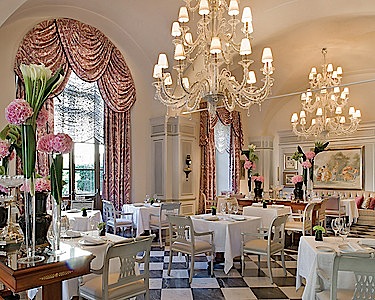 vaulted ceilings,
crystal chandeliers, artwork of the renaissance era,
Sambonet silver, and crisp white linens, a
design that expresses elegance, beauty,
simplicity and opulence all in one and the perfect
setting to complement
Chef Mollica’s style of cooking. Dishes such as
Tyrrhenian bonito tartare with
Sarconi beans and red onion; homemade pici pasta with
guinea fowl ragout; and ‘Montespertoli’ pigeon cooked
in pork bladder with vin santo all show the use
of local and typical ingredients in dishes produced
with the craftsmanship
of a great talent. The menu can also be enjoyed in the
form of a tasting menu
should you want to experience the most of Chef
Mollica. You may also have your dinner al
fresco on the
outside terrace overlooking the landscape of the Four
Seasons very own eleven-acre Giardino della
Gherardesca.
vaulted ceilings,
crystal chandeliers, artwork of the renaissance era,
Sambonet silver, and crisp white linens, a
design that expresses elegance, beauty,
simplicity and opulence all in one and the perfect
setting to complement
Chef Mollica’s style of cooking. Dishes such as
Tyrrhenian bonito tartare with
Sarconi beans and red onion; homemade pici pasta with
guinea fowl ragout; and ‘Montespertoli’ pigeon cooked
in pork bladder with vin santo all show the use
of local and typical ingredients in dishes produced
with the craftsmanship
of a great talent. The menu can also be enjoyed in the
form of a tasting menu
should you want to experience the most of Chef
Mollica. You may also have your dinner al
fresco on the
outside terrace overlooking the landscape of the Four
Seasons very own eleven-acre Giardino della
Gherardesca.
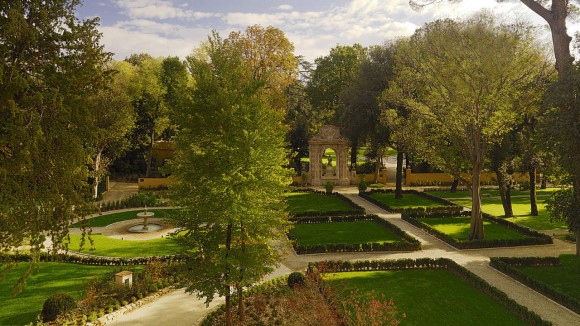 After dinner, don’t hesitate to take a
stroll through the garden (below) of perfectly manicured
foliage. Softly lit, this garden is
home to rare botanical varieties of evergreens that
will provide an
escape from the hustle and bustle of the Firenze city
life. Tranquility in
the heart of Florence. After dinner the night we
stayed in the Four Seasons,
we stopped into the Atrium Bar late night for an after
dinner cordial of grappa and Marsala, made our
way to our sumptuous, slid into the exceptionally
comfortable bed imaginable, and slipped into our dream
worlds with smiles of
total contentment on our faces.
After dinner, don’t hesitate to take a
stroll through the garden (below) of perfectly manicured
foliage. Softly lit, this garden is
home to rare botanical varieties of evergreens that
will provide an
escape from the hustle and bustle of the Firenze city
life. Tranquility in
the heart of Florence. After dinner the night we
stayed in the Four Seasons,
we stopped into the Atrium Bar late night for an after
dinner cordial of grappa and Marsala, made our
way to our sumptuous, slid into the exceptionally
comfortable bed imaginable, and slipped into our dream
worlds with smiles of
total contentment on our faces.
The next morning when we awoke, we were suppose
to drive to Pisa, but because of the
blissfulness of our Four Seasons accommodations, we
looked at each other and decided, “Eh,
let’s enjoy every last second of this; this is too
special," and so delayed our departure.
Our next destination was south of Florence, in
the hills of Montalcino (below), It's a small fortress
town located just south of Siena, and its fame
is attributed to
one of the greatest wines of the world, for this is
where where the
famous wine Brunello is produced. Back in the
mid to late 19th century, the Biondi-Santi family had
isolated a specific clone of sangiovese grape that
they found thrived and showcased
their area and terroir like no other planted in the
region. It was a grape
that showed great potential, balance, expression,
depth, complexity and
age ability. Up until this point no Italian wines
could rival the greatest French wines,
but this all changed when Biondi-Santi named this
clone Sangiovese Grosso, BBS11,
which became the benchmark and, a century later,
the DOCG standard for all Brunello
production.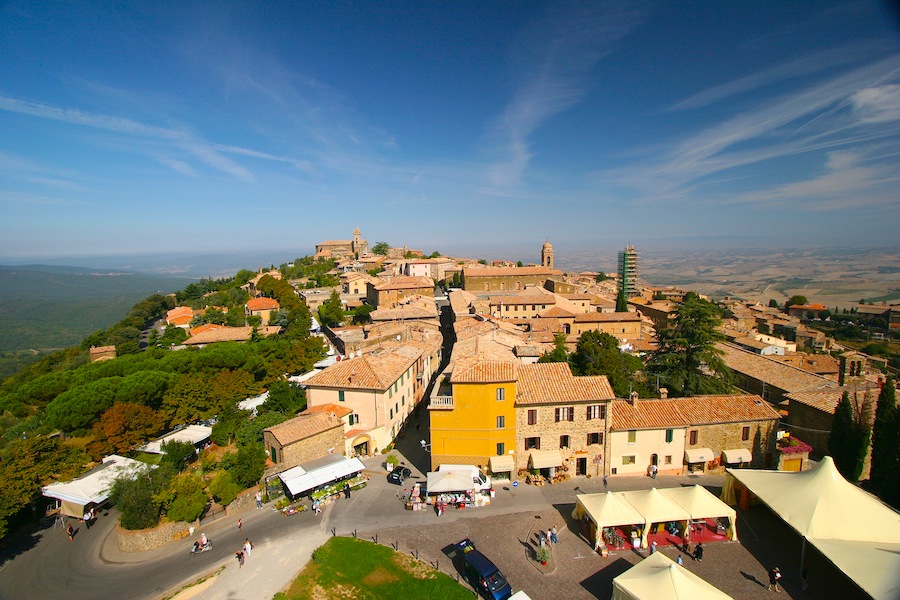
Biondi-Santi was a leader in a movement in the
area, but later down the road,
another leader and trail blazer would make their way
onto the scene. This man,
American none the less, was John Mariani, not related
to my father of the same name. The Mariani
family had run an importing business in the U.S.
out of NY, and
with the Italian cooperative Reunite produced
the incredibly
popular Lambrusco in the 60’s, becoming the number one
imported wine.
In 1978, Banfi purchased
vineyards in Montalcino and started producing their
very own Brunello.
What has made Banfi such a prominent and
important name in the region and the wine
world is not just that they make their own great
wines, but that they have been an
integral part of maintaining and developing the region
as a whole, all the while
preserving and upholding the
highest level of environmental consciousness
and dedication to the betterment of the DOCG by
financing ampelographic
research to isolate the best and most ideal clones
for production,
narrowing 650 clones down to 15, which they openly
shared with their
neighbors. Banfi has won International Winery of the
Year four times and Italian Winery
of the Year nine times.
We headed down
SS2 and reached the entrance road to the estate.
Navigating our way
through rows and vineyards and roads lined with
cypress trees, we pulled up to
the wholly restored Castello, a sight so
familiar, since I had been there
before almost 12 years ago. Much has changed in this
time but much has
remained the same. I remember seeing barren vineyards
along the entrance road with
soil being turned in preparation of new vines soon to
be planted; now they
were healthy, bountiful rows. Back then, when I had
visited the estate, we
had stayed in their farm house, isolated in the
vineyards, with a corral in the
back that harbored donkeys; one, Aristotle, is still
there to this day. Now,
Castello Banfi has built a full-blown resort called Il
Borgo of luxury suites
and accommodations. Rooms dressed in a modern and
elevated farm house motif
provide the ultimate Tuscan Wine getaway.
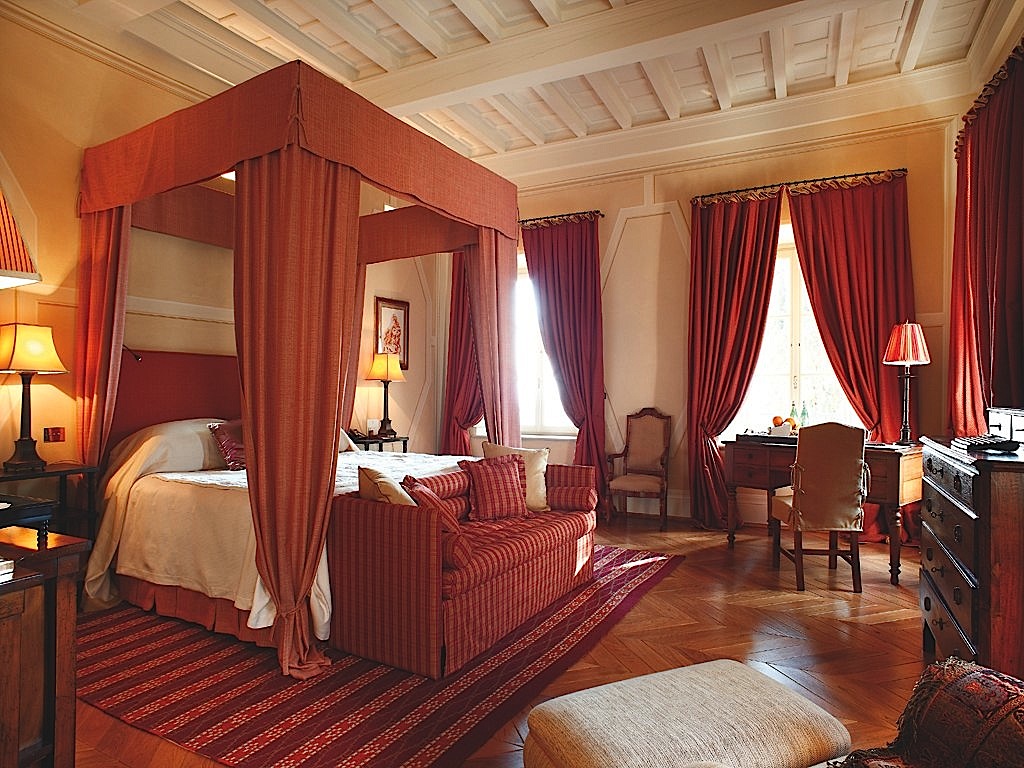 When
we arrived, there is a small gated parking area to
park your car for guests of
Il
Borgo. We pulled in, and as I crept into the
parking lot, I noticed that
there happened to be a Club of Ferrari owners staying
the night. So, with no choice,
I parked my Fiat 500 between million dollar vintage
Ferraris. Of course I
was excited to see these cars, but all of a sudden, my
super cool 101 hp Fiat
wasn’t as much fun. Nonetheless, when I was greeted by
the concierge and hotel
managers, I was treated just as if one of those
Ferraris were mine. The
hospitality was genuine and abundant.
When
we arrived, there is a small gated parking area to
park your car for guests of
Il
Borgo. We pulled in, and as I crept into the
parking lot, I noticed that
there happened to be a Club of Ferrari owners staying
the night. So, with no choice,
I parked my Fiat 500 between million dollar vintage
Ferraris. Of course I
was excited to see these cars, but all of a sudden, my
super cool 101 hp Fiat
wasn’t as much fun. Nonetheless, when I was greeted by
the concierge and hotel
managers, I was treated just as if one of those
Ferraris were mine. The
hospitality was genuine and abundant.
We were walked to our room (left), and as we
stepped out from a covered staircase, we
entered into a white rose garden with vineyards in the
background
that sat at the footstep of our room’s door. Here was
the ideal country gentleman's room--decorated with
exquisite,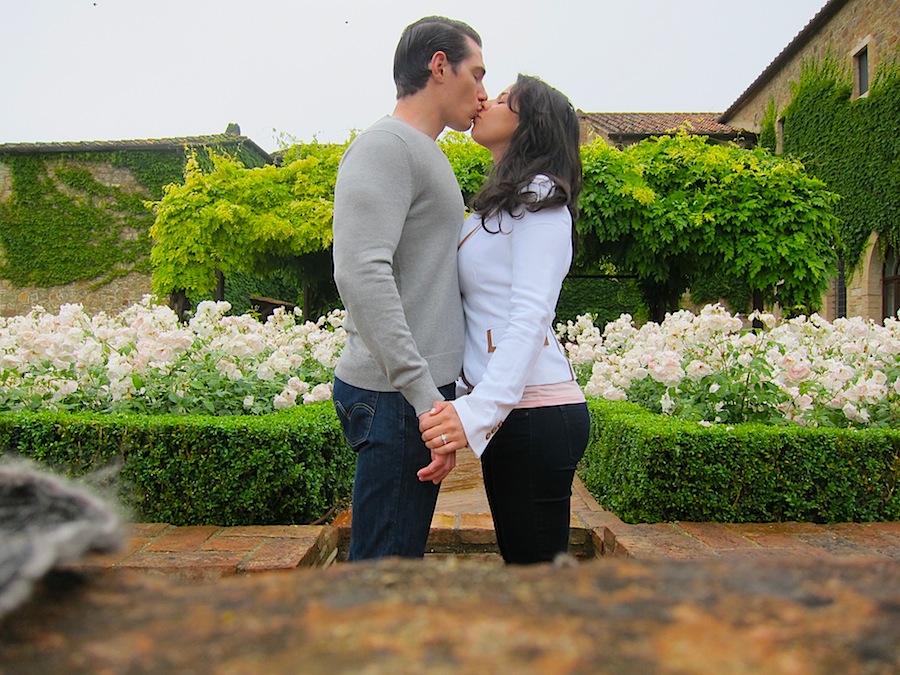 restrained taste that had
the hand of an American in its comfort and amenities,
which included a gorgeous bathroom that begged you to
soak in the marble tub for hours. After settling in
and getting our
second wind, we started getting ready for dinner and
headed to the restaurant
just set off of the castle for a enjoyable evening of
food and wine.
The
Taverna trattoria, much frequented by visitors to
the area, is a delight, just rustic enough to relax
in, but with a menu of sophisticated Tuscan cooking
that is a textbook example of the form.
restrained taste that had
the hand of an American in its comfort and amenities,
which included a gorgeous bathroom that begged you to
soak in the marble tub for hours. After settling in
and getting our
second wind, we started getting ready for dinner and
headed to the restaurant
just set off of the castle for a enjoyable evening of
food and wine.
The
Taverna trattoria, much frequented by visitors to
the area, is a delight, just rustic enough to relax
in, but with a menu of sophisticated Tuscan cooking
that is a textbook example of the form.
The
following day, we had the luxury of taking a wine tour
of the estate, an
amenity offered to all guests of Banfi. To kick off
the tour, we started in the
tasting room with lineups such as the Rosso di
Montalcino, Poggio alle
Mure (their single vineyard production), and their top
bottling Poggio all’Oro.
All are top-notch examples in their own right,
showcasing Banfi’s commitment to
constant development and increased used of modern wine
making techniques.
Wines with balance, persistence, power and identity
all the while having
finesse.
Castello Banfi is not just a place to visit
while driving through this prominent wine
rich region, but a place where you can splurge, be
taken care of and indulge
yourself within the world of vino. There aren’t many
places that can offer
the extensive experience Castello has to offer. Or as
many Ferraris to check out in case you're in the
market.
No one who has gone to
Tuscany has resisted its romantic appeal, and with my
new fiancee, Priscilla (right), alone in Il Borgo's white
rose garden, everything came into wonderful focus for
our life ahead.
by John Mariani
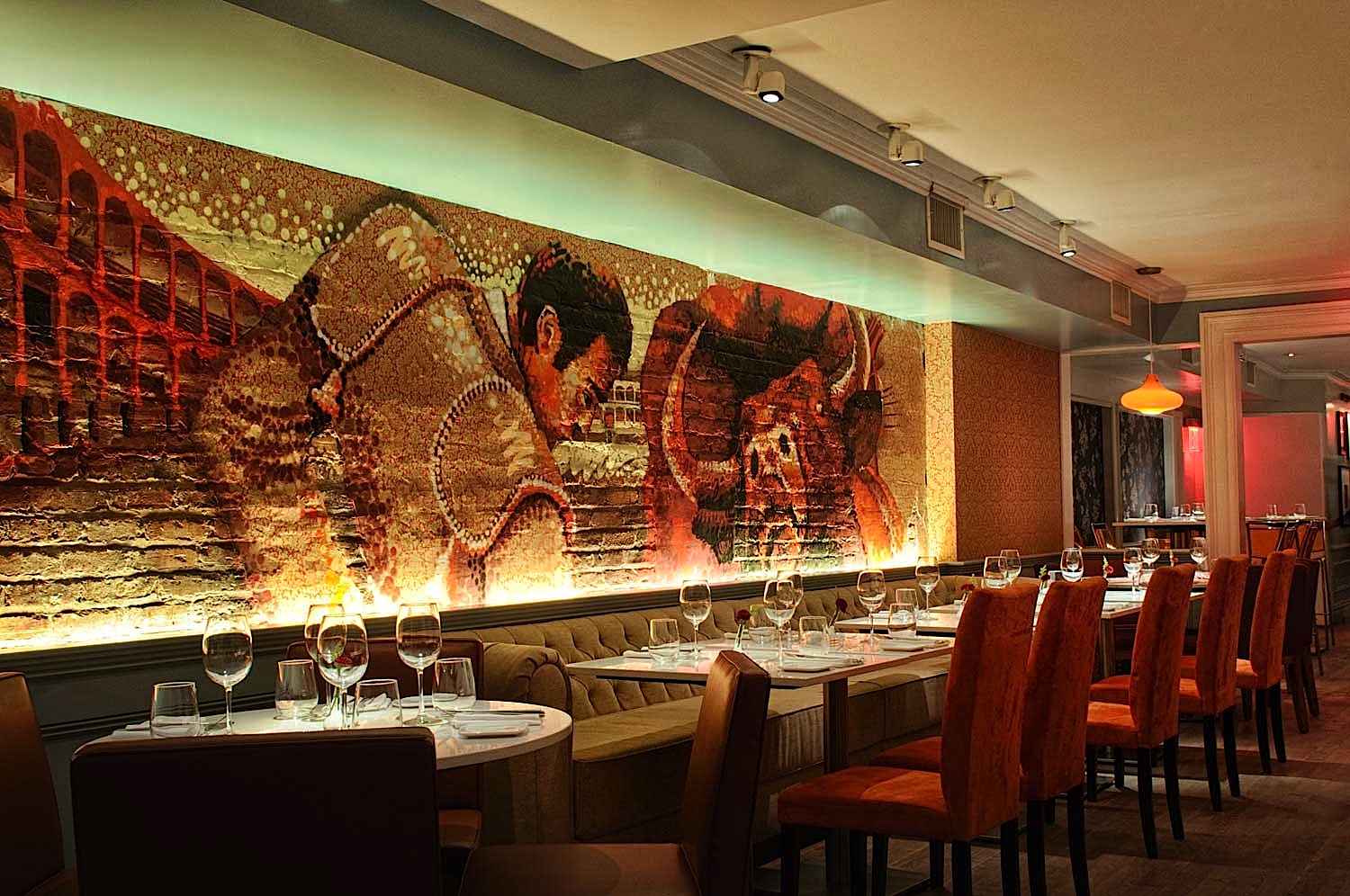 The
controversy that swirls around what contemporary
Spanish cuisine really is may have more to do
with hype than the reality of what is really
going on in 99 percent of the restaurants in
Iberia today, for the influence on a few young
Spanish chefs of the avant-garde techniques of
Ferran Adrìa has sadly veered away from
what makes traditional Spanish cuisine so good,
so varied in region and so fascinating.
The
controversy that swirls around what contemporary
Spanish cuisine really is may have more to do
with hype than the reality of what is really
going on in 99 percent of the restaurants in
Iberia today, for the influence on a few young
Spanish chefs of the avant-garde techniques of
Ferran Adrìa has sadly veered away from
what makes traditional Spanish cuisine so good,
so varied in region and so fascinating. Andanada, a new restaurant on the Upper West Side, strikes a very happy medium by being on the one hand respectful of Spanish tradition while presenting its food with flair, esthetics and a few modernist twists that makes it one of the most interesting new restaurants in America. Owner and partner Alvaro Rainoso, the son of the owner of the Rioja winery Tobelos, studied in the U.S. to be a software engineer but longed for good Spanish cooking in NYC. He thereupon founded The Spaniards NYC company that organizes events; then, drawn to the restaurant business, Reinoso sought to open his own, bringing in Chef Manuel Berganza, who had worked at the Michelin-starred restaurant La Broche ion Madrid, then as exec chef at Sergi Arola, also with a Michelin star.
So one expects innovation in the cooking here but he and Reinosos have very wisely chosen to show with pride the true flavors of Spanish cuisine without ever over-complicating anything. The name Andanada refers to the highest seating area in the bullfighting arena, considered the best view, and there is a fine mural of bullfighter Enrique Ponce in this, one of the handsomest new dining rooms in NYC. There is color everywhere,
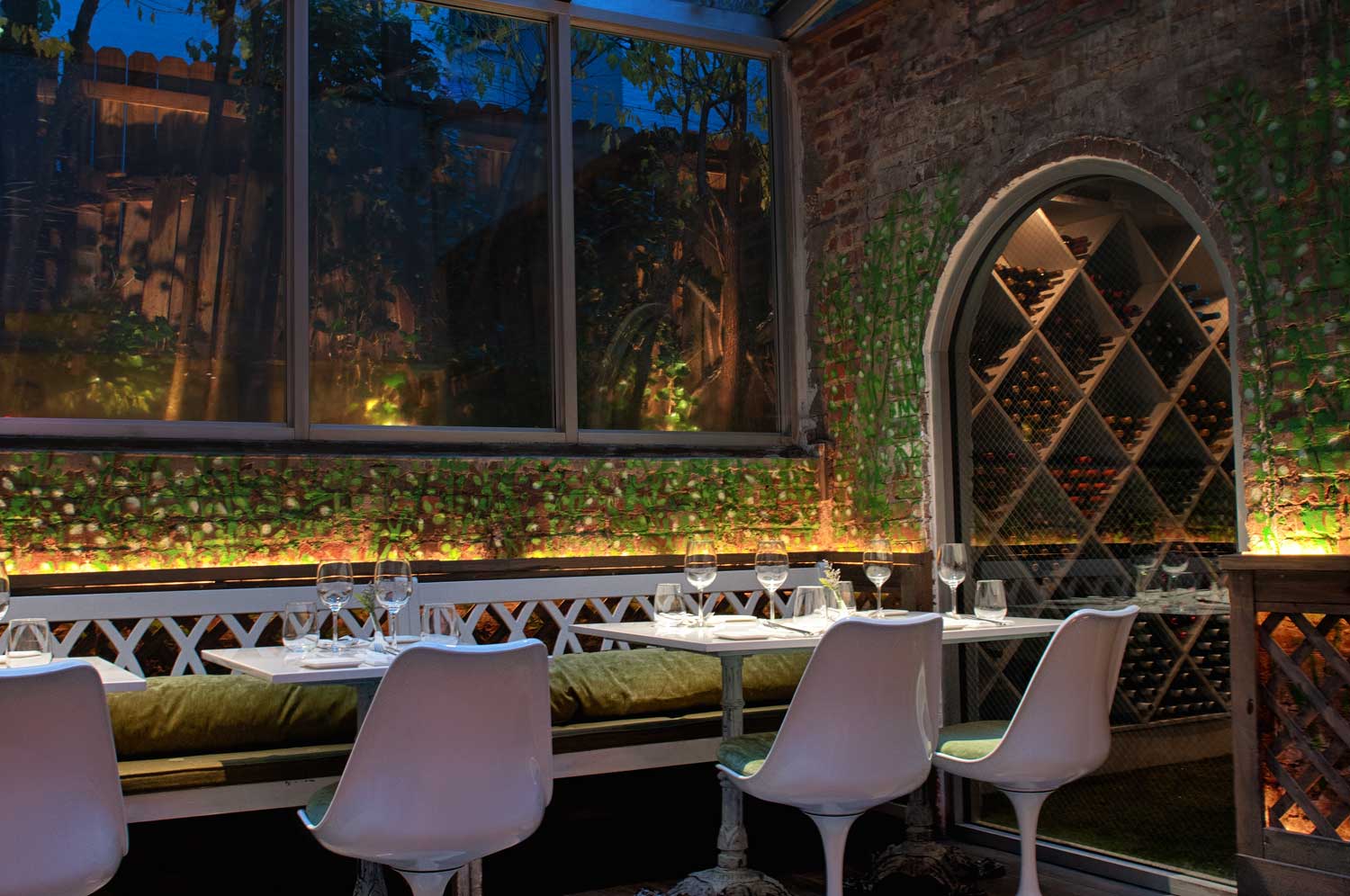 excellent lighting,
modern furniture and a real evocation of Spanish
motifs, along with a glass-roofed garden atrium
with trompe l'oeuil painted vines and white
benches. Chipirones
(calamari) with squid ink were delicious fried
excellent lighting,
modern furniture and a real evocation of Spanish
motifs, along with a glass-roofed garden atrium
with trompe l'oeuil painted vines and white
benches. Chipirones
(calamari) with squid ink were delicious fried The principal part of the menu is devoted to tapas, with a nightly list appended with specials that either will soon or will not go onto the regular menu. We ordered several, started with patatas Andanada, their version of the classic, spicy patatas bravas, here rendered as boiled potatoes set in a "soil" of dehydrated olives, with aïoli and salsa brava dipping sauces--an example of just about how far the food goes in the Modernist style.
Berenjenas asadas come as a pretty platter of roasted, smoky eggplant, with red wine vinegar reduction and chives, a dish I found a little bitter but which my table guests adored for just that reason. Very traditional was a dish of plump shrimp cooked in a fiery garlic sauce, brought to the table in a ceramic dish. Croquettas de jamon, widely found in tapas bars, are as always completely addictive--hot ham croquettes lavished with a rich béchamel that spurts out onto the palate. Fabulous. Calamari with aioli were delicious, as was fried artichokes with Manchego cheese.
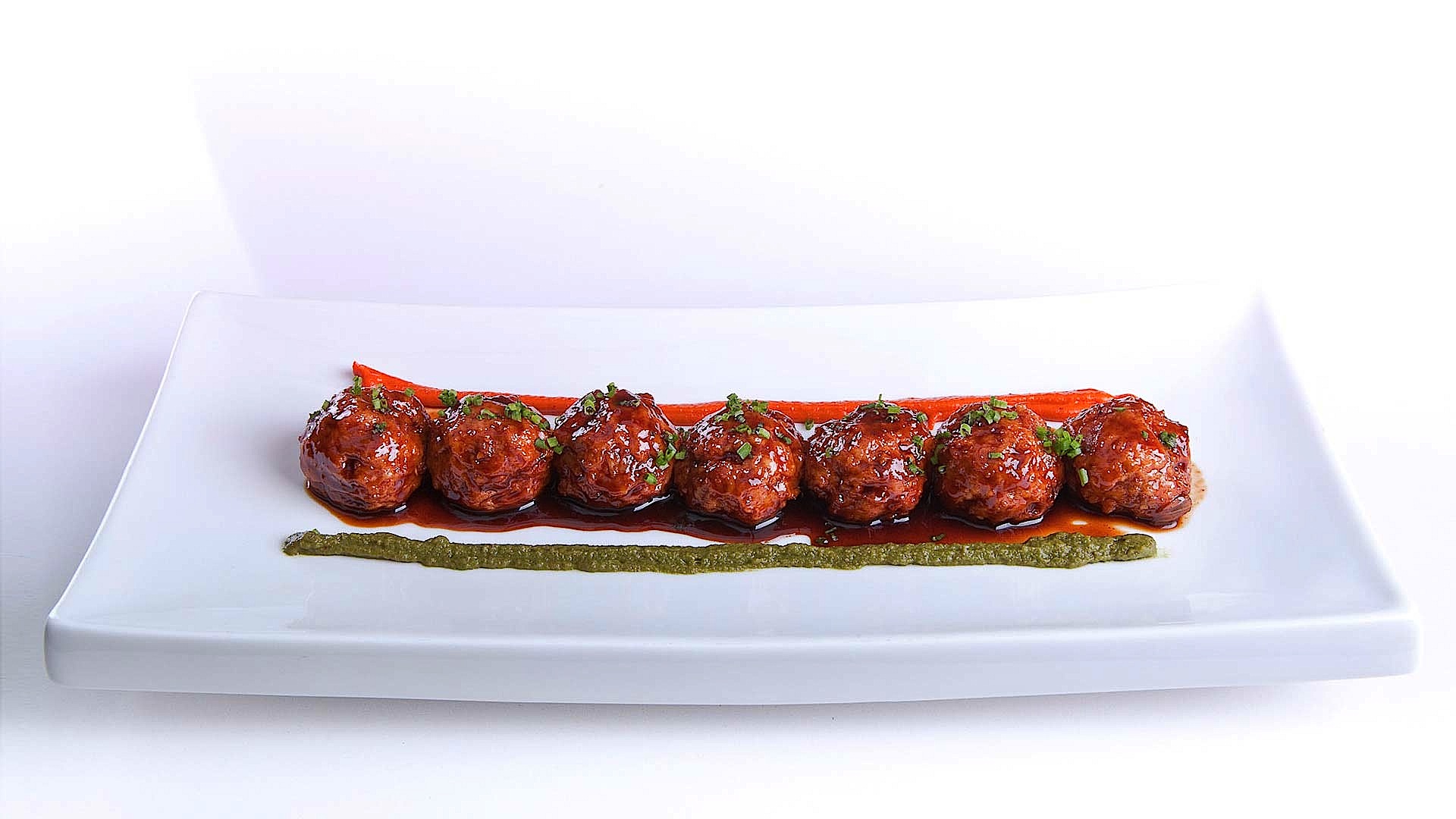 There are
several intriguing seafood dishes here, and we
thoroughly enjoyed plancha-seared, seasoned cod
over a carpaccio of portobello mushrooms with pine
nut emulsion and vegetables.
There are
several intriguing seafood dishes here, and we
thoroughly enjoyed plancha-seared, seasoned cod
over a carpaccio of portobello mushrooms with pine
nut emulsion and vegetables. I highly recommend the stuffed suckling pig, with burnished , very crispy skin and a salad of Romain lettuce, pickled onion, cherry tomatoes and pepper puree, a dish where everything was in perfect equilibrium to bring out the best in the pig. Andanada now has a paella menu and we choose the meat version, cooked with chewy rice and vegetables in broth. I went back for second helpings--though I did miss the crackling crusty rice called soccarat sought out by paella fans.
Desserts are where the chef has some fun: arroz con leche is cinnamon flavored pudding, but beneath lies crispy flash-fried rice paper that looks like quickly folded handkerchiefs. Chocolate mousse comes with wonderful spiced bread and berries macerated in olive oil and vanilla with a goat's cheese tart lashed with orange juice and a poof of almond powder.
The wine list is resolutely Spanish, with sever good reds under $50 and quirkily named cocktails like The Beet Goes On.
The word has gotten out on the Upper West Side about Andanada, but it's safe to say that people from Lincoln Center and anyone who loves modern Spanish cuisine will soon find this one of the best newcomers in that neck of the Manhattan woods.
Andana is opn for dinner nightly Tapas and apps run $6-$16, main courses $28-$32.
❖❖❖
by John Mariani
OREGON RIESLINGS RIVAL EUROPE'S BEST IN TASTE AND PRICE
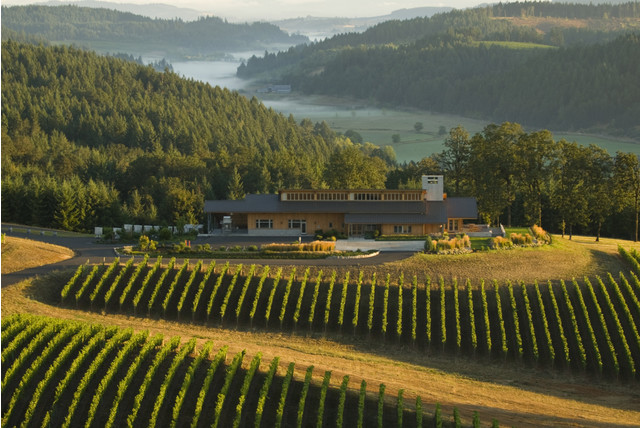 Wine
making is a romantic obsession -- a good selling
point for an agricultural product marketed as
seductive, sophisticated and highly cultured. Truth
is, most winemakers make money by following global
trends, resulting in oceans of white wines all
tasting pretty much the same. This is not generally
true of riesling, whose archetypes lie in the
valleys of Germany and Alsace. Unlike chardonnay,
pinot blanc and other white varietals, the grape
itself has a very particular flavor.
Wine
making is a romantic obsession -- a good selling
point for an agricultural product marketed as
seductive, sophisticated and highly cultured. Truth
is, most winemakers make money by following global
trends, resulting in oceans of white wines all
tasting pretty much the same. This is not generally
true of riesling, whose archetypes lie in the
valleys of Germany and Alsace. Unlike chardonnay,
pinot blanc and other white varietals, the grape
itself has a very particular flavor.
Penner-Ash Vineyards
Rieslings are spicy, brisk, sometimes racy, often
sweet, always aromatic and low in alcohol. And while
many different regions make riesling, I think Oregon
now can compete with the world’s best -- especially
when the average price is under $20 a bottle. A
cooler climate than California’s
is
key to riesling’s excellence in Oregon, where it has
grown into a $2.7 billion industry, with 450
wineries, mostly small and artisanal, spread over 17
distinct American Viticultural Regions. Average
winery yield is only 5,000 cases a year, and nearly
40 percent of the state’s vineyard acreage is
certified sustainable. Fifty wineries now make
riesling with 797 acres under cultivation, which is
only about 5 percent of Oregon plantings, down from
23 percent 30 years ago, after vines were ripped out
to make way for cabernet and chardonnay.
Harry Peterson-Nedry, founder and
winemaker of Chehalem winery, says rieslings are the
world’s “best white wine” and insists the varietal
will eventually be the most widely planted in the
state. “New dense plantings with a full array of
clones are the future,” he says, “as we investigate
sites for epiphanies and stretch styles to palates
and foods.” Back in the 1980s and into the 1990s,
Oregon rieslings were not as elegantly knit as they
are today. Some are still as flabby as fruit punch;
others lack the acidity of New
York State Finger Lake examples.
German rieslings, with hundreds of years of
development, are still the benchmark, including
intensely sweet dessert wines. But drier styles are
now justifiably getting attention.
The International Riesling
Foundation has produced a Riesling
Taste Profile based on sugar-to-acid ratios, info
that members may print on the label: “Dry,” “Medium
Dry,” “Medium Sweet” and “Sweet.”
Here are
some of the Oregon rieslings I have been enjoying
this summer, with just about everything except a
steak on the grill.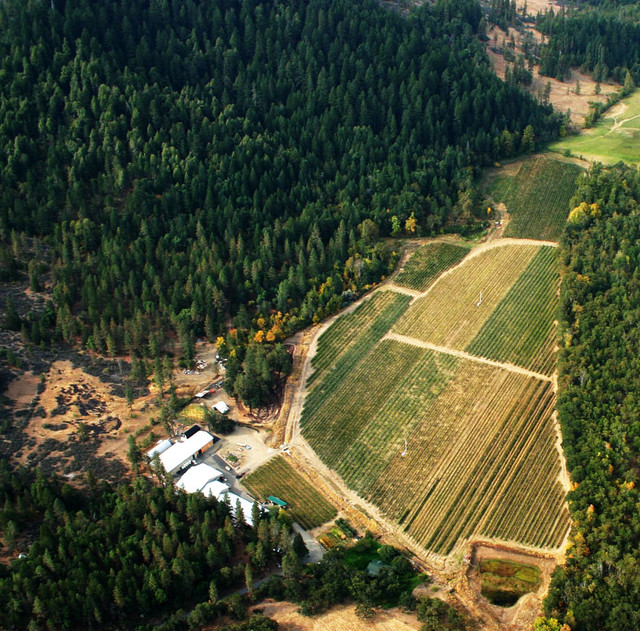
Argyle Eola-Amity Hills
2011 ($18)
The 2011 vintage is considered one of the best of
the past decade, a cool year with low sugars but
good acids. Argyle, one of the pioneers in the
Willamette Valley, is best known for its sparkling
wines. But this medium-dry riesling is full of
tropical fruit flavors and spice, which make it a
good aperitif and a delight with an appetizer of
honeydew melon and slices of prosciutto.
Penner-Ash 2012 ($20)
Bottled in March 2013, this lighter riesling, at
10.5 percent alcohol, is very drinkable right now.
I’d love it to have a bit more acid, but I easily
sipped this before dinner with nothing more than
some walnuts and pistachios. It also pairs well with
shellfish.
Anne Amie Estate Dry
Riesling 2011 ($20)
The Yamhill-Carlton district vineyards, dating to
1979, show their terroir with plenty of spice and
dry minerality. Better known for their pinot noir
and pinot blanc, Anne Amie
uses old vine riesling grapes and treats them with
minimal processing, keeping yield low to produce a
superb intensity in their riesling, along with a
refreshing acidity to balance the sugars. This is
the ideal wine for trout or any lake fish.
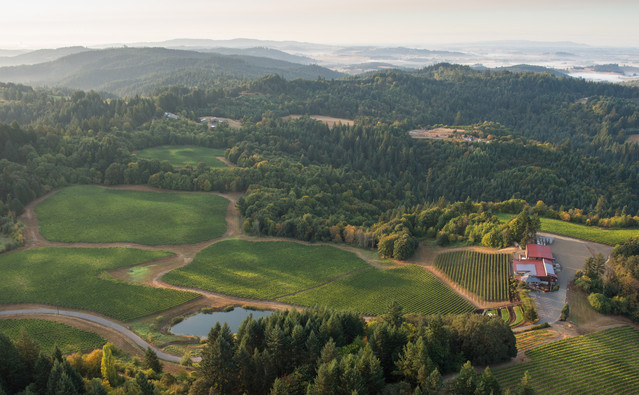 Foris Rogue
Valley 2011 ($13.50) (right)
Foris Rogue
Valley 2011 ($13.50) (right)
If you love a good, crisp, tangy apple, you might be
forgiven for thinking this bottling was full of
apple juice. It is absolutely delicious, a very deft
balance of pale sweetness with edgy acids. Foris,
which started producing under its own label in 1986,
is the southernmost winery in Oregon, and its
bottlings are clear expressions of the high
elevation, cool Pacific terroir, allowing the wine’s
components to knit together without complications
from too much sun. They also sell a 2008 sweet
late-harvest dessert riesling at $12 for a
half-bottle.
Elk
Cove Vineyards Willamette Valley Estate 2011
($19) (left)
Elk Cove’s pinot noirs have an outstanding
reputation, but I’m almost as impressed by their
Estate riesling, which has plenty of aroma, fruit
and spices, and at 12 percent alcohol is a wine I’d
like to keep around for a couple of years to see if
it develops into something even finer. Right now, if
grilled salmon were on the plate, this riesling
would be in the glass.
Any of John Mariani's
books below may be ordered from amazon.com.
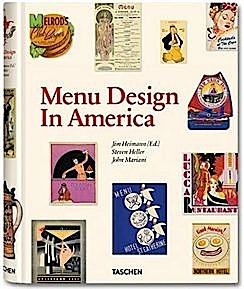 |
My latest book, which just won the prize for best book from International Gourmand, written with Jim Heimann and Steven Heller, Menu Design in America, 1850-1985 (Taschen Books), has just appeared, with nearly 1,000 beautiful, historic, hilarious, sometimes shocking menus dating back to before the Civil War and going through the Gilded Age, the Jazz Age, the Depression, the nightclub era of the 1930s and 1940s, the Space Age era, and the age when menus were a form of advertising in innovative explosions of color and modern design. The book is a chronicle of changing tastes and mores and says as much about America as about its food and drink.
“Luxuriating vicariously in the pleasures of this book. . . you can’t help but become hungry. . .for the food of course, but also for something more: the bygone days of our country’s splendidly rich and complex past. Epicureans of both good food and artful design will do well to make it their coffee table’s main course.”—Chip Kidd, Wall Street Journal.
“[The menus] reflect the amazing craftsmanship that many restaurants applied to their bills of fare, and suggest that today’s restaurateurs could learn a lot from their predecessors.”—Rebecca Marx, The Village Voice. |
"Eating Italian will never be the same after reading John Mariani's entertaining and savory gastronomical history of the cuisine of Italy and how it won over appetites worldwide. . . . This book is such a tasteful narrative that it will literally make you hungry for Italian food and arouse your appetite for gastronomical history."--Don Oldenburg, USA Today. "Italian
restaurants--some good, some glitzy--far
outnumber their French rivals. Many of
these establishments are zestfully described
in How Italian Food Conquered the World, an
entertaining and fact-filled chronicle by
food-and-wine correspondent John F.
Mariani."--Aram Bakshian Jr., Wall Street
Journal.
"Equal parts
history, sociology, gastronomy, and just
plain fun, How Italian Food Conquered the
World tells the captivating and delicious
story of the (let's face it) everybody's
favorite cuisine with clarity, verve and
more than one surprise."--Colman Andrews,
editorial director of The Daily
Meal.com. "A fantastic and fascinating
read, covering everything from the influence
of Venice's spice trade to the impact of
Italian immigrants in America and the
evolution of alta cucina. This book will
serve as a terrific resource to anyone
interested in the real story of Italian
food."--Mary Ann Esposito, host of PBS-TV's
Ciao
Italia. "John Mariani has written the
definitive history of how Italians won their
way into our hearts, minds, and
stomachs. It's a story of pleasure over
pomp and taste over technique."--Danny Meyer,
owner of NYC restaurants Union Square Cafe,
Gotham Bar & Grill, The Modern, and
Maialino.
|
 |
 |
 |
 |
 |
 |
 |
 |
 Everett Potter's Travel Report:
Everett Potter's Travel Report: 
 Eating Las Vegas
is the new on-line site for Virtual Gourmet
contributor John A. Curtas., who since 1995
has been commenting on the Las Vegas food
scene and reviewing restaurants for Nevada
Public Radio. He is also the
restaurant critic for KLAS TV, Channel 8 in
Las Vegas, and his past reviews can be
accessed at KNPR.org.
Click on the logo below to go directly to
his site.
Eating Las Vegas
is the new on-line site for Virtual Gourmet
contributor John A. Curtas., who since 1995
has been commenting on the Las Vegas food
scene and reviewing restaurants for Nevada
Public Radio. He is also the
restaurant critic for KLAS TV, Channel 8 in
Las Vegas, and his past reviews can be
accessed at KNPR.org.
Click on the logo below to go directly to
his site.

Tennis Resorts Online: A Critical Guide to the World's Best Tennis Resorts and Tennis Camps, published by ROGER COX, who has spent more than two decades writing about tennis travel, including a 17-year stretch for Tennis magazine. He has also written for Arthur Frommer's Budget Travel, New York Magazine, Travel & Leisure, Esquire, Money, USTA Magazine, Men's Journal, and The Robb Report. He has authored two books-The World's Best Tennis Vacations (Stephen Greene Press/Viking Penguin, 1990) and The Best Places to Stay in the Rockies (Houghton Mifflin, 1992 & 1994), and the Melbourne (Australia) chapter to the Wall Street Journal Business Guide to Cities of the Pacific Rim (Fodor's Travel Guides, 1991).


MARIANI'S VIRTUAL GOURMET
NEWSLETTER is published weekly. Editor/Publisher: John
Mariani.
Contributing Writers: Christopher Mariani, Robert Mariani,
John A. Curtas, Edward Brivio, Mort Hochstein,
Suzanne Wright, and Brian Freedman. Contributing
Photographers: Galina Stepanoff-Dargery,
Bobby Pirillo. Technical Advisor: Gerry McLoughlin.
© copyright John Mariani 2013

